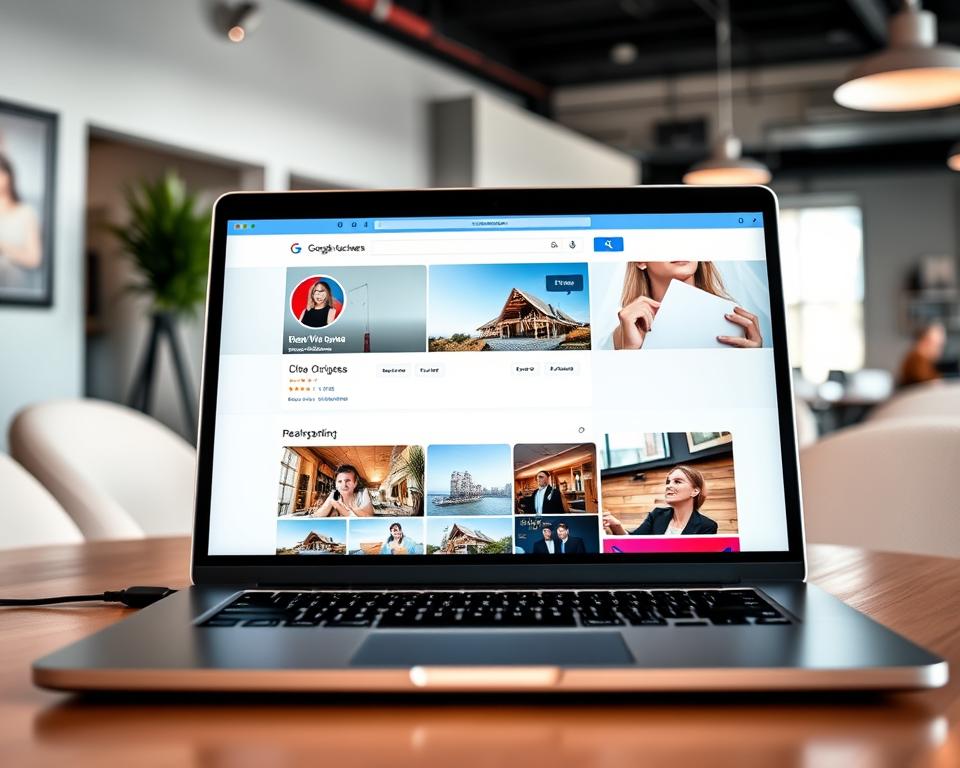GMB Appointment Link Optimization: Local SEO Strategies
“To predict the future, create it.” — Peter Drucker
You can boost bookings with a free Google Business Profile. According to BrightLocal, an average profile sees 1,260 monthly views yet just 59 actions. That gap is where GMB appointment link optimization steps in.
First steps in GMB optimization: claim and verify the profile. Make sure to fill out every field and keep your info up to date. That approach builds credibility and brings in more visits. A clearly placed appointment link acts as a direct path to conversions.
Trends for 2025 feature AI matching and geo-tagged photography. Reviews mentioning local areas and services remain essential to SEO consultant Drenthe. Marketing1on1 implements these best practices to raise booking rates and increase local visibility. This makes the GMB appointment link work harder for every searcher.
Why appointment link optimization matters for Google Business Profile visibility
An optimized profile turns searchers into actions. A prominently placed appointment link lets customers book without leaving the profile. This reduces friction and boosts conversion rates for local businesses in competitive markets.
A clearly visible appointment link signals strong booking intent to Google’s local system. When users see a clear booking option, they often complete tasks right on the profile. This lifts CTA ratios and can improve discovery visibility.
How appointment links shape user behavior
People scan profiles to find quick actions. A clearly visible scheduling element directs visitors to book, call, or message. A streamlined booking flow reduces steps, lowers drop-off, and increases high-intent interactions.
Impact on zero-click and high-intent searches
Zero-click searches are growing as users complete tasks on the results page. An appointment link supports this trend. With high intent, a booking link turns interest into bookings without another click.
Support from engagement metrics & BrightLocal

- Profiles with appointment links show higher action rates in platform insights.
- BrightLocal-style reports highlight that freshness and active features, like scheduling, correlate with increased views and actions.
- Analytics with UTMs identify which appointment link practices drive bookings.
Clear metrics help prioritize appointment scheduling optimization. Watching APV and tuning best practices offers a path to stronger visibility and bookings.
Optimizing appointment links on GMB
Businesses looking to increase bookings need to know about appointment links on Google Business Profile. An appointment link is a direct call-to-action that leads users to a booking flow. It may point to a supported scheduler or an in-house reservation page. Place the link in the dashboard to make scheduling easy for users.
Definition and scope
An appointment link on Google appears as one of several action buttons. Other buttons include website, directions, and call. It should link to a page for scheduling, not a generic homepage. Salons, dentists, spas, and medical offices commonly use this because their categories signal they’re ready for bookings.
How Google views appointment vs. website links
Appointment links signal high intent to Google. They may appear as a prominent CTA on the profile. A standard website link is more informational. Making sure the appointment link matches the Business Profile category increases the chance it will be shown to users looking to book.
KPIs to track
- GMB Insights: appointment link clicks.
- GA4-measured sessions from UTM-tagged links that convert to bookings.
- Track conversion rate and time-to-book for friction points.
- Bounce rate on the appointment page and steps-to-book completion.
- Downstream outcomes like no-show rate and revenue per booking.
Using GMB Insights with GA4 helps understand how well appointment link optimization works. Teams should improve landing pages, use UTMs, and check weekly trends. These steps improve GMB link SEO and optimization. Clear tracking focuses efforts on optimizing the scheduling link and lowering funnel drop-off.
Setting up the appointment link in GBP
Claim and verify your Business Profile at Google.com/business before adding an appointment link. Keep NAP and hours correct and consistent across the web. Clean profiles reduce issues with the appointment button.
Adding the scheduling link in the dashboard
Sign in to the Business Profile Manager. If unclaimed, use the “Own this business?” flow. Once verified, add the booking URL or provider link and save.
Supported booking platforms and linking
Google accepts many booking partners and direct appointment page URLs. The chosen platform should be mobile-friendly and reliable. Test the provider link on mobile to ensure it works well before adding it to the profile.
Verification & troubleshooting
Verification is needed to manage profile features. You can verify by postcard, phone, or email, depending on your business type. You cannot add the appointment link without verification.
- Missing button? Check category + verification.
- Confirm the booking URL does not redirect through disallowed domains.
- Ensure NAP on the appointment page matches the Business Profile to avoid Google flags.
- In sensitive niches, avoid unsupported systems to retain features.
Manage links by testing after updates and monitoring regularly. Review settings, test flows, and re-verify if requested. That ensures the scheduling experience remains smooth.
GMB link management: best practices
Begin with consistency for strong link management. Ensure appointment page NAP matches your GBP. It builds Google’s trust and prevents customer confusion.
Keep hours and holiday schedules aligned on the appointment page and GBP. Inconsistencies cause confusion. Local number consistency and clear contacts enhance experience and optimization.
UTMs + GA4 enable tracking of appointment link traffic. Include source/medium/campaign in the scheduling URL. This reveals booking origins in analytics. Use GA4 events to record appointments and see which listings or posts lead to the most conversions.
- Keep a consistent UTM schema across posts/ads/links.
- Keep UTMs intact through redirects.
- Map GA4 events to booking milestones such as “checkout” or “confirm”.
Rotate links and CTAs for seasonal campaigns. Use campaign-specific appointment pages for holidays and promos. Point GMB posts and profile links to those pages. Accurate reporting depends on preserved UTMs and clean redirects.
Test links regularly to follow appointment link best practices. Make sure they work on mobile, return the right contact details, and don’t break during busy times. Audits maintain optimization and a smooth booking flow.
Keep a record of link changes, seasonal pages, and UTM conventions in a shared calendar or content sheet. It streamlines updates, maintains NAP, and increases scheduling link performance.
Conversion optimization for appointment link destinations
Your appointment link destination can make or break conversions. Align the page with GBP and provide a clear path to book. Ensure hours and location are easy to find.
Elements that improve booking completion
Write clear headlines consistent with the profile. Position a strong CTA above the fold. Keep booking forms short and simple.
Inline reviews and partner badges raise trust. A simple calendar picker also helps increase booking rates.
Mobile-first & fast loads reduce drop-off
Most local searches occur on mobile. A mobile-first design makes buttons easy to tap. Keep the booking flow smooth.
Optimize images and use fast hosting to keep load times low. That reduces bounce and improves link effectiveness.
Trust elements that matter
Display recent reviews and star ratings near the form. Display clear pricing and add staff photos. This helps customers feel confident.
Geo-tagged images from the Business Profile can also help. Trust cues signal strong optimization. They improve visitor confidence upon arrival.
Track conversions and iterate frequently. Minor changes can have major impact. Ongoing testing keeps optimization aligned with behavior and trends.
How to use SEO for GMB appointment links
Match appointment pages to queries to grow visibility. Place relevant keywords in title, H1, meta, and body for GMB link SEO. This prevents crowding your business name in GBP.
Keyword alignment matters on pages and meta elements. Include city/service phrasing such as “Book a dental cleaning in Chicago”. This boosts appointment link optimization GMB and aligns with local search intent.
Link from your site to the booking page to build authority. Include CTAs on service pages, contact, and footer. Use descriptive anchors like “Book a haircut in Austin” for clarity.
Schema and structured data make booking details easy for machines to read. Implement LocalBusiness/Service plus Appointment/Booking schema. Add availability, priceRange, and booking URL to connect page data with GBP actions.
- Make sure the appointment page has clear H1s and meta descriptions that match GMB categories.
- Use descriptive anchors linking from key pages to the booking URL.
- Implement schema listing services, locations, and booking URL.
These tactics can increase rankings and clicks. Combined, they move users from results to bookings and support long-term goals.
Leveraging photos, posts, and Q&A to promote the appointment link
Use photos, posts, and Q&A to improve bookings. Frequent images/Posts signal freshness. Q&A helps by answering questions and guiding customers to book.
Photos to build trust
Post new photos weekly and tag them with locations. Show both inside and outside views. Team photos build trust and engagement.
Posts with strong CTAs
Share Google Posts 1–2 times a week. Promote offers, events, and hours. Always add a “Book Now” link. Holiday and local event posts can perform well.
Seed the Q&A to reduce friction
Answer common questions to make booking easier. Provide clear directions and reference the scheduling link. Monitor Q&A to correct inaccuracies and keep flow smooth.
- Vary photos to reflect seasons and updates.
- Align posts with events, launches, and promos.
- Seed Q&A with local keywords plus booking link.
Using these strategies can boost your local presence. Regular GMB management and focused link optimization can turn profile views into real visits.
Reviews & reputation for better conversions
Your reputation strongly influences behavior. Good reviews can make someone want to book an appointment. Service/location mentions in reviews help local visibility.
Request service and location mentions in reviews. Examples: “teeth cleaning in Austin,” “massage near Brooklyn”. That helps Google understand offerings and improves discoverability.
Make it easy for customers to leave feedback. Place a review link post-booking, in emails, and on receipts. Asking prompts reviews, which can lead to more bookings.
Use polite and brief review requests that link to the Google review form. Automate post-appointment review requests. That keeps reviews tied to booking.
Always respond to reviews quickly. Thankful replies to positive reviews build trust. For negative feedback, offer a calm solution and ask to talk offline. It demonstrates care and can increase booking likelihood.
Monitor how reviews influence bookings. UTM-tag confirmation pages to attribute bookings to reviews. You’ll learn what resonates and what needs adjustment.
Advanced: local backlinks & partnerships
Local backlinks increase appointment page visibility in neighborhood searches. They make booking links more prominent. Securing city-level pages linking to booking URLs improves local relevance.
Focus on civic and community sites that list trusted vendors. Chambers, libraries, and neighborhood associations often list partners. These listings can include the appointment URL, acting as referral paths and local backlinks for GMB.
Partner with event organizers and local directories to increase referral traffic. Featured directory spots or sponsor blurbs can drive clicks. This keeps booking URLs visible in places locals trust.
Leverage PR and sponsorships for authoritative local mentions. Press that links to booking pages signals local authority. Marketing teams at agencies like Marketing1on1 can help secure high-value, hyper-local backlinks for GMB.
Maintain link quality by auditing partners and avoiding low-value directories. Focus on relevance, editorial context, and accurate contact details. This approach safeguards GMB link SEO and strengthens appointment link optimization GMB through trusted, city-level referrals.
Set goals: X city pages, Y directory listings, Z media mentions per quarter. Track referral clicks and conversion gains to identify effective partners. Use those insights to refine appointment link best practices and scale what works locally.
Monitoring & analytics for GMB appointment links
Monitoring appointment link performance is essential. It helps maintain direction for local campaigns. Adopt a weekly routine to check clicks/engagement. This way, you can quickly notice any trends or spikes related to promotions or events.
Key metrics in GMB Insights
GMB Insights provides views, searches, and actions. When your appointment link is clicked, it’s recorded as a unique action. Tracking clicks, calls, and directions shows how users interact.
Combining GMB Insights with GA4 and UTM data
UTM-tag appointment links to track performance in GA4. It’s important to send booking completions as GA4 events. You’ll track conversion, bounce, and other metrics to gauge impact.
Weekly insight reviews and action steps
Review weekly to catch trends and impacts. If clicks drop, updating a Google Post or refreshing photos might help. Rising clicks around events? Scale offers fast.
- Report cadence: weekly snapshot of appointment link clicks, sessions, and conversions.
- Cross-check Insights vs. GA4 to catch attribution gaps.
- Optimization list: update posts, test CTAs, refresh LP elements, rotate images.
Agencies like Marketing1on1 use this cadence to keep link management aligned. Combining Insights, GA4, and UTMs clarifies the path from views to bookings.
Final thoughts
A fully optimized GBP is a free, high-value local acquisition channel. A GMB appointment link converts intent into bookings. This should be part of any local effort to capture active shoppers in the United States.
Completing your profile, using accurate NAP, and posting geo-tagged photos are all important. They reinforce appointment link conversions. Continual optimization/verification lowers friction and builds trust.
That improves foot traffic and leads. Structured data, local links, and weekly analytics can further improve visibility and booking rates. Marketing1on1 and similar firms can execute these for measurable gains.
Common Questions
What is a GBP appointment link and how does it work?
It’s a dedicated booking URL on your GBP. Customers can book directly within the profile. The link may point to a third-party scheduler or a mobile-optimized page on your site.

